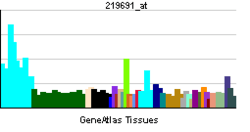SAMD9
Sterile alpha motif domain-containing protein 9 is a protein that in humans is encoded by the SAMD9 gene.[2]
References
Further reading
- Maruyama K, Sugano S (1994). "Oligo-capping: a simple method to replace the cap structure of eukaryotic mRNAs with oligoribonucleotides". Gene. 138 (1–2): 171–174. doi:10.1016/0378-1119(94)90802-8. PMID 8125298.
- Suzuki Y, Yoshitomo-Nakagawa K, Maruyama K, et al. (1997). "Construction and characterization of a full length-enriched and a 5'-end-enriched cDNA library". Gene. 200 (1–2): 149–156. doi:10.1016/S0378-1119(97)00411-3. PMID 9373149.
- "Toward a complete human genome sequence". Genome Res. 8 (11): 1097–108. 1999. doi:10.1101/gr.8.11.1097. PMID 9847074.
- Strausberg RL, Feingold EA, Grouse LH, et al. (2003). "Generation and initial analysis of more than 15,000 full-length human and mouse cDNA sequences". Proc. Natl. Acad. Sci. U.S.A. 99 (26): 16899–16903. doi:10.1073/pnas.242603899. PMC 139241
 . PMID 12477932.
. PMID 12477932.
- Scherer SW, Cheung J, MacDonald JR, et al. (2003). "Human chromosome 7: DNA sequence and biology". Science. 300 (5620): 767–772. doi:10.1126/science.1083423. PMC 2882961
 . PMID 12690205.
. PMID 12690205.
- Hillier LW, Fulton RS, Fulton LA, et al. (2003). "The DNA sequence of human chromosome 7". Nature. 424 (6945): 157–164. doi:10.1038/nature01782. PMID 12853948.
- Ota T, Suzuki Y, Nishikawa T, et al. (2004). "Complete sequencing and characterization of 21,243 full-length human cDNAs". Nat. Genet. 36 (1): 40–45. doi:10.1038/ng1285. PMID 14702039.
- Gerhard DS, Wagner L, Feingold EA, et al. (2004). "The status, quality, and expansion of the NIH full-length cDNA project: the Mammalian Gene Collection (MGC)". Genome Res. 14 (10B): 2121–2127. doi:10.1101/gr.2596504. PMC 528928
 . PMID 15489334.
. PMID 15489334.
- Topaz O, Indelman M, Chefetz I, et al. (2006). "A deleterious mutation in SAMD9 causes normophosphatemic familial tumoral calcinosis". Am. J. Hum. Genet. 79 (4): 759–764. doi:10.1086/508069. PMC 1592555
 . PMID 16960814.
. PMID 16960814.
- Li CF, MacDonald JR, Wei RY, et al. (2007). "Human sterile alpha motif domain 9, a novel gene identified as down-regulated in aggressive fibromatosis, is absent in the mouse". BMC Genomics. 8: 92. doi:10.1186/1471-2164-8-92. PMC 1855325
 . PMID 17407603.
. PMID 17407603.
- Dereure O (2007). "[SAMD9 mutation in normophosphatemic familial tumoral calcinosis]". Annales de dermatologie et de vénéréologie. 134 (5 Pt 1): 505–505. doi:10.1016/S0151-9638(07)89230-1. PMID 17507861.


 . PMID 12477932.
. PMID 12477932. . PMID 12690205.
. PMID 12690205. . PMID 15489334.
. PMID 15489334. . PMID 16960814.
. PMID 16960814. . PMID 17407603.
. PMID 17407603.